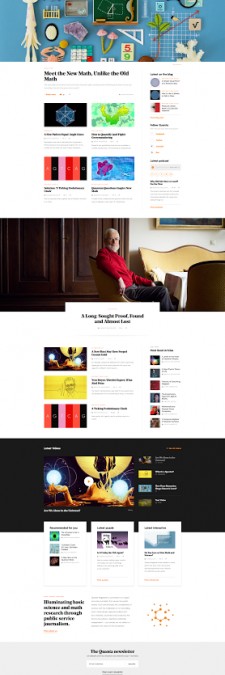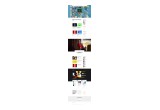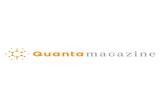New Quanta Magazine Website Makes Complex Science Come to Life

New York, NY, May 2, 2017 (Newswire.com) - Quanta Magazine today reintroduced itself to science and math explorers by unveiling its new logo and a redesigned website. Although the new site reflects the growth of its editorial offerings and brand, Quanta remains one of a kind.
A new breed of science journalism:
"Quanta Magazine is consistently superb. It's head and shoulders above anything else out there for science and math coverage. It goes beyond the latest press releases and looks at important trends and breakthroughs with great depth and clarity. The stories are deep and accurate, as well as beautifully written and engaging. It's the best source I know for keeping up with the latest advances in mathematics, computer science, theoretical physics and quantitative biology."
Steven Strogatz, Popular math writer and Jacob Gould Schurman Professor of Applied Mathematics at Cornell University
From its inception, the magazine has used deep reporting, well-crafted narratives and elegant visuals to cover the often-underreported issues and outcomes at the cutting edge of scientific and mathematical exploration.
"If you aren't reading @QuantaMagazine, you are missing some of the finest, sharpest science writing of our time," tweeted Maria Popova (@brainpicker), founder of the popular blog Brain Pickings.
Quanta’s business model — it is funded by the Simons Foundation, from which it is editorially independent — enables it to cover mathematics and the ‘basic’ or ‘pure’ sciences in depth, something few mainstream publications are able to do. It is one of the new breed of privately funded yet journalistically independent media outlets that are immune to the vagaries of advertisers and politics, and which strive to use that advantage to consistently and responsibly enlighten the public.
Since its launch in 2013 as Quanta, the site has attracted a loyal and rapidly growing audience — it had over 3 million visitors in 2016. And it has expanded its editorial offerings beyond its core news articles and features to include columns, blog posts, videos, interactives, puzzles and podcasts.
Quanta has partnered with major media outlets such as Wired and The Atlantic to help expand their science coverage. Syndication of Quanta articles has enabled these and several other popular publications — in English, German, Japanese, Spanish and other languages — to provide their readers with excellent coverage of math and science, free from paywalls. Quanta’s nonprofit-foundation-funded business model enables it to offer its content widely, at no cost, with only public service in mind.
Quanta’s rigor is undisputed: Even the scientific elite rely on it. "I regard the establishment of Quanta Magazine as the greatest thing to happen to science journalism in many years," says David Gross, a Nobel-Prize-winning physicist and former director of the Kavli Institute for Theoretical Physics.
"Quanta is my favorite science magazine,” says Sean Carroll, research professor of physics at the California Institute of Technology and author of “The Big Picture: On the Origins of Life, Meaning, and the Universe Itself.”
“There is no place like it for in-depth, serious coverage of cutting-edge topics — especially for deep, penetrating analyses that other outlets might shy away from,” says Carroll. “It's a unique resource that everybody who loves science should have at the top of their reading list."
An award-winning team:
Thomas Lin, formerly of The New York Times, launched Quanta with the help of the Simons Foundation, aiming to bring the most rigorous journalistic coverage possible to significant research outcomes in mathematics, physics, computer science and biology. As the magazine took off, he brought on board two long-time science editors: Michael Moyer, formerly of Scientific American, and, most recently, John Rennie, former editor-in-chief of Scientific American.
To date, three Quanta articles have been selected for the “Best Writing on Mathematics” anthologies:
- “A Proof That Some Spaces Can’t Be Cut” by Kevin Hartnett
- “Mathematicians Chase Moonshine’s Shadow” by Erica Klarreich
- “At the Far Ends of a New Universal Law” by Natalie Wolchover
Senior physics writer Natalie Wolchover also received the 2016 Evert Clark/Seth Payne Award, the Council for the Advancement of Science Writing's annual prize for young science journalists, for four of her articles in Quanta:
- “Gravitational Waves Discovered at Long Last”
- “The Quantum Secret to Superconductivity”
- “Visions of Future Physics”
- “A Fight for the Soul of Science”
The redesign:
Quanta partnered with designers at Belgium-based DogStudio, developers at New-York-based Barrel and strategists at Atlantic Media Strategies to reimagine and reinvent its website, logo and brand story.
The new site dovetails aesthetically and technologically with modern user needs and expectations. It renders beautifully across devices and platforms, and related content is more seamlessly integrated. Users will find it easier to share Quanta’s stories on social media, to engage in conversations on the site and to search for specific content.
Editors have been given new tools to highlight the best bits of information for site users, and, in turn, users now have tools to curate personalized reading lists.
“While our commitment to incisive, accurate reporting remains the same, this is a complete reimagining of the Quanta experience,” says Thomas Lin, the magazine’s founding editor-in-chief. “Staying informed about the biggest mysteries in the universe need not feel like falling into a black hole. It can be expansive, open and delightful.”
More praise for Quanta:
“Quanta Magazine is consistently superb. It’s head and shoulders above anything else out there for science and math coverage. It goes beyond the latest press releases and looks at important trends and breakthroughs with great depth and clarity. The stories are deep and accurate, as well as beautifully written and engaging. It's the best source I know for keeping up with the latest advances in mathematics, computer science, theoretical physics and quantitative biology," said Steven Strogatz, popular math writer and Jacob Gould Schurman Professor of Applied Mathematics at Cornell University.
"I've written a new story on complexity. It's for Quanta, which I see as the ProPublica of science," said Carl Zimmer, science columnist at The New York Times and best-selling author, on Twitter.
“@WIRED continues its great record of showcasing some of the best science writing on the web. @QuantaMagazine,” said Adam Savage, former co-host of MythBusters (television), tweeting a Quanta article syndicated on Wired.com.
"I rely on Quanta Magazine to cover the most fascinating and challenging scientific themes with a depth and range that other venues wouldn't brave. Their eloquent writers create provocative, energizing stories, never dumbing down but rather lifting the reader up," said Janna Levin, popular science author, novelist and associate professor of physics and astronomy at Barnard College
Available for interview about Quanta Magazine:
- Thomas Lin, founder and editor-in-chief (formerly of The New York Times)
- Michael Moyer, deputy editor (formerly of Scientific American)
- John Rennie, deputy editor (formerly editor-in-chief of Scientific American)
Available for interview about their Quanta articles:
- Natalie Wolchover, senior physics writer
- Kevin Hartnett, senior math writer
Press contact: Anastasia Greenebaum, communications director, Simons Foundation; agreenebaum@simonsfoundation.org, 212.524.6097
---
About Quanta
Quanta Magazine makes complex science come to life. Quanta offers in-depth, authoritative news coverage of mathematics, physics and basic life science research. Quanta readers can expect content that is newsworthy, timely, trustworthy, compelling and accurate. Quanta is an editorially independent publication of the Simons Foundation. It covers developments in mathematics, theoretical physics, theoretical computer science and the basic life sciences. To experience the new Quanta Magazine, visit quantamagazine.org.
Source: Quanta Magazine



